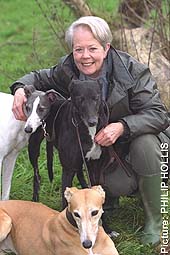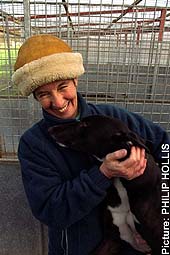 |
Each year thousands of
greyhounds are abandoned after a life of racing or coursing. Tony
Jackson reports on the campaign to look after these animals
THE horror
stories are endless. Two-year-old Andy, a gentle black-and-white
greyhound, was discovered locked in an abandoned car in woodland.
He'd been there for five days. Four greyhounds were found on a
Yorkshire moor, muzzled and left to starve to death. Rosie, dumped
on the M1, was eventually rescued by the police, having somehow
avoided being killed. She was in a state of extreme terror.
 |
|
Out
of the traps: Annette Crosbie with three of her rescued
greyhounds | Each
year thousands of greyhounds, the majority of them young, healthy
dogs, are put down by vets or abandoned under the most appalling
circumstances, many by owners who are not prepared to pay training
fees for racing no-hopers. A lucky few - and it's only a tiny
percentage - end up in rescue centres and are re-homed as family
pets.
"The basic problem is simple," says the actress Annette Crosbie,
who is probably best known for her portrayal of the long-suffering
wife in One Foot in the Grave. "Hundreds of greyhounds are bred in
the hope of getting a winner. The remainder are surplus to
requirements and have no future. It is, bluntly, a state of affairs
which reflects little glory on Britain as a nation of so-called
animal lovers."
About 18 months ago Crosbie, with fellow actress Charlotte
Cornwell, formed Greyhounds UK to act as a ginger group. "The idea,"
she says, "is to try and achieve publicity, because until the public
realises what is going on, politicians won't do anything. We've
asked a home affairs committee to look at evidence. It did look at
greyhound racing in 1991 and made some recommendations about
welfare, all of which have been ignored by the industry. There's no
statutory control and they do what they like."
Crosbie admits that she is now far more interested in the welfare
of greyhounds than in acting. "It's a battle to be fought and, for
me, greyhounds come first. Sometimes I'm offered work but I know
I'll be away from my desk for too long."
Having always owned dogs, when Crosbie read how difficult it was
to find homes for retired greyhounds, she thought she'd give it a
go. "I got one from the Retired Greyhound Trust as a companion for
my mongrel, but I was very disappointed with the after-care. Today,
they do provide information for new owners, but at that time there
was no follow-up. When the mongrel died, someone mentioned the Celia
Cross Greyhound Trust, so I visited its kennels near Guildford. I
saw all these beautiful, sad greyhounds looking for homes. Instead
of one I came away with two, so now I've got three. The great thing
with Celia Cross is that you get wonderful after-care."
According to Crosbie, the dogs are easy to look after at home.
"They're a very laid-back breed and don't need constant stimulation
as terriers do. They don't want to be the centre of attention, but
prefer to be in the same room as you, when they'll curl up and go to
sleep."
Official figures record that 9,000 greyhounds are retired every
year in this country. Of these, the Retired Greyhound Trust says
that 2,000 are found homes, many will be kept by their owners, while
others end up in rescue centres. But these figures are based only on
the 33 registered tracks that race under the rules of the sport's
governing and self-regulatory body, the National Greyhound Racing
Club; there are a further 27 independent "flapping" tracks, which
are unsupervised.
Geoffrey Thomas, the chief executive of the British Greyhound
Racing Board, is frank. "We still haven't got the number of homes we
would like for retired racing greyhounds and 500 to 1,000 have to be
put down each year. However, we try to ensure owners find a home for
their dogs and we make it clear in our promotional material that
potential owners should not buy a dog if they are not prepared to
see it re-homed."
 |
|
Judie
Brookes: manager of the Celia Cross Greyhound Trust, with some
of the animals at the Sun Valley
Kennels | Michael
Spencer, the treasurer and trustee of Greyhound Rescue West of
England, believes that the number of greyhounds that come out of
racing and coursing plus those abandoned by travellers and private
owners could be as high as 25,000 each year. Van-loads of
greyhounds, he alleges, come in from Ireland to be dumped in
Britain, and cruelty is rife. Dogs are left on railway lines, thrown
off bridges, drowned or let loose on motorways.
Greyhound racing is all about gambling. If dogs survive racing
injuries, most are finished by the age of four, because they are
worn out. A greyhound can live up to 14 years, but most of those
that come into rescue centres are under three. These are dogs that
simply will not race or cannot make the grade. Older dogs taken in
are racing rejects or, increasingly, dogs dumped when marriages
break up.
The National Canine Defence League is also at the forefront of
greyhound rescue. It has 15 rescue centres throughout the country
and in 1994, staff reported that one-third of the dogs being taken
in were greyhounds, with few people wanting to re-home them. That
situation, as Clarissa Baldwin, the league's managing director,
explains, has definitely improved. "It's becoming easier to re-home
greyhounds and more people are taking them on. One of the problems
is discovering the statistics of abandoned greyhounds. We need an
independent authority to control greyhound racing and to take into
account aspects of welfare."
An independent statutory authority would be one way forward and
it is, believes Crosbie, urgently needed if the greyhound racing
world is to present an acceptable face to the public.
How you can care for a greyhoundby Tara Womersley
Organisations such as the National Canine Defence League and
Retired Greyhound Trust will vet potential owners to make sure that
their homes are suitable for the dogs.
- While many greyhounds will not chase other animals, it is
advisable, says Judie Brookes of the Celia Cross Greyhound Trust, to
muzzle the dog initially.
- Greyhounds are unused to being let loose off a track and can run
into trees and walls. They should be be kept on a lead in confined
spaces to start with.
- Two or three short walks a day (even if on a lead) should be
sufficient. Greyhounds also eat the same amount and type of food as
any other dogs their size.
- A duvet will provide an ideal bed for a greyhound as they like
to make nests.
- A greyhound's nails should be kept trimmed - otherwise they can
cause injury.
- Many greyhounds are house-trained from the start. If this is not
the case, it should only take a short time to house-train them
providing that owners are firm but gentle.
- Greyhounds UK: 020 8542 4497. Retired Greyhound Trust: 020 8335
3016. National Canine Defence League: 020 7837 0006
|